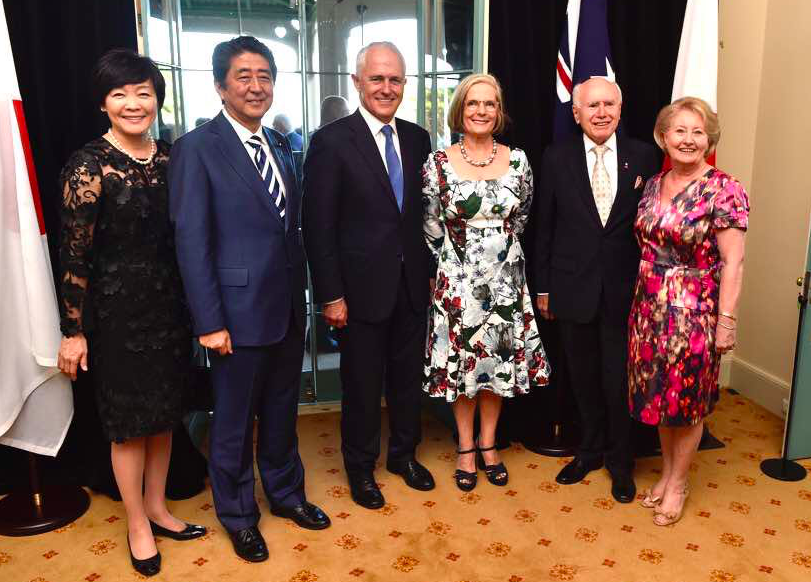
Since the 1960s, Australia and Japan have built one of Asia’s closest partnerships. I was going to say one of Asia’s most unusual, but lots of relationships in this region are strange.
When times get tough in Asia, Tokyo and Canberra are always talking and trying to plan. Once a peculiar partnership, constant tending has rubbed away the strangeness. The habit of closeness is based on huge trade interests, constant meeting of minds, common needs, agreement on means—and twin alliances with the US.
As an Asian pairing, Japan and Oz have become a comfortable, status quo marriage–their only argument in public is about whaling. Please don’t mention that spectacular upset about submarines; best forgotten, if not forgiven.
While not overdoing the national psyche interpretation, part of the relationship glue is Japan’s conception of itself as a unique nation in Asia and Australia’s status as an Asian outsider. Here are two nations that feel different. And then there’s the shared obsession with the US.
In the last quarter of the 20th Century, the constant Canberra-Tokyo focus was framed by trade and economics, reflecting the way Japan saw the world. In the first quarter of the 21st Century, the flavour has turned strategic as Japan’s views have broadened.
Having bedded down the bilateral trade relationship in the 1960s, Japan and Australia mounted a joint effort to build Asian architecture; Asia Pacific governments would create systems to secure the trade sinews created by business.
The institutional construction of a Pacific economic community evolved through a series of Oz-Japan proposals from the 1960s to the 1990s. As a journalist, I covered a key moment: the Pacific Community Seminar held at Canberra’s Shine Dome in September, 1980. Called by the Prime Ministers of Japan and Oz, the conference was chaired by Sir John Crawford, giving birth to the Pacific Economic Cooperation Council, and leading to another Canberra creation moment in 1989, the formation of APEC (Asia Pacific Economic Cooperation).
Crawford is credited with the seminal term ‘open regionalism’, although he attributed it to the Japanese. In the same way, Australia gets creation rights for APEC yet this was another partnership production with Tokyo. Indeed, Asia’s hardheads saw Oz more as Japan’s front man.
I thought of that 1980 conference last week as I passed the Shine Dome and went a couple of hundred metres further along to the J.G. Crawford building. The Crawford link was only part of the echo. Australia’s National Security College was hosting a major conference with Japan doing plenty of the lifting on the topic of prospects and challenges for strategic cooperation between Australia, Japan and the US.
The tone was set by the College’s new paper on the coming of Donald Trump: ‘Don’t panic, don’t relax.’ Outside the Crawford building, signs warned about the danger of snakes in the grass. Inside, the fear was about the new Washington elephant trampling the grass.
Japan is ever on guard against the chance of another Nixon shock/Kissinger surprise of the magnitude of Washington’s 1972 rapprochement with China.
Japan’s former Defence Minister, Satoshi Morimoto, summoned up that dread with his description of a Trump tete-a-tete in a small room with China’s leaders, doing a deal ‘with no notification to US allies’.
‘My personal concern on the unpredictability and uncertainty of Donald Trump and the trend of the Trump administration is the future prospect of US-China relations. Especially, I worry President Trump may make a deal and a compromise with China.’
From Keio University, Professor Yuichi Hosoya, listed four changes in the regional order that confront Japan and Australia:
- China’s rise has ‘radically changed strategic relations in the region’.
- The Trump administration promises ‘more shocks and anxiety’. The new President will ‘betray his own words’ and ‘not respect his own words’.
- The spread of nationalism and populism in Asia will ‘make diplomatic solutions based on rational compromises more difficult than before’.
- The decline of the Liberal International Order: Donald Trump shows no respect for norms, order or justice—only ‘interests are important’.
China plus Trump. No wonder the Japanese Embassy estimates that Shinzo Abe and Malcolm Turnbull spent a total of eight hours together during Abe’s flying visit to Sydney. After that, Japan’s PM flew off to repeat the urgent business in Southeast Asia.
No front man needed. In rounding up Asia, Abe is doing it from the front. The shift from geo-economics to geopolitics has seen Japan discard its modesty. In his separate meetings with President Trump and the new US Defence Secretary, James Mattis, Abe can speak for many in the region as well as Japan. Much is changing in Asia when Japan reaches naturally for strategic leadership.
When the US-Japan-Australia trilateral was being created early in the previous decade, the push was from Australia and the US (the Bush and Howard governments). Japan was the small steps, slowly-slowly recruit.
Today Japan is the partner putting the push into the trilateral. Abe wants to repurpose it as an instrument of influence directed at Trump. Australia seconds the idea.
The trilateral designed to help Japan emerge is suddenly all about stopping the US from reneging. The Australia-Japan partnership exhibits new urgency in securing the established relationship with the US. Tokyo and Canberra look to Washington for an embrace not a choke hold, a firm grip not a shove-off.